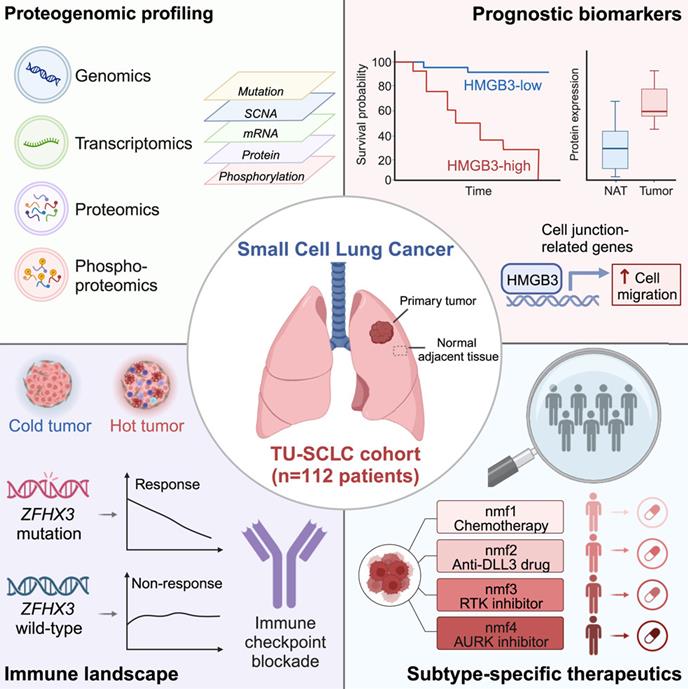In a new study, a research team led by Professor Zhang Peng of the Shanghai Lung Hospital affiliated with Tongji University, China, Professor Zhou Hu of the Chinese Academy of Sciences Shanghai Institute of Materia Medica, Professor Gao Daming and Ji Hongbin of the Molecular Cell Science Innovation Center of the Chinese Academy of Sciences Shanghai Institute of Biochemistry and Cell Biology has reported for the first time a large-scale study on the proteomic and phosphorylated proteomic characteristics of clinical cohorts of small cell lung cancer (SCLC), providing a comprehensive overview of SCLC protein genomics.
The relevant research results have recently been published in the Cell journal, with the title “Proteogenomic characterization of small cell lung cancer identifies biological insights and subtype-specific therapeutic strategies “.
This new study reveals the molecular characteristics of SCLC and proposes new subtypes of SCLC molecules and targeted personalized treatment strategies, laying a solid foundation for better understanding the underlying mechanisms of SCLC and improving clinical treatment strategies.
Lung cancer is the most common malignant tumor worldwide. SCLC accounts for about 15% of all lung cancer cases, characterized by fast cell proliferation, strong metastasis, high drug resistance, the highest malignancy and mortality rate, and a five-year survival rate of only 5%. However, the treatment progress of SCLC is slow, and feasible therapeutic targets and precision therapies that can significantly improve survival rates have not yet been identified.
In this new study, these authors collected tumor and matched adjacent tissue samples from 112 Chinese SCLC patients who underwent surgical resection, and conducted a comprehensive analysis of multiple omics including whole exome sequencing, transcriptomics, proteomics, and phosphorylated proteomics.
These authors first discovered through somatic mutations and copy number loss that TP53 and RB1 are the main gene changes in SCLC. They found that compared to the Western population, the Chinese population has a higher frequency of mutations in the ZFHX3 gene. They pointed out that gene mutations in TP53, FAT1, and GNAS have an impact on their expression, and FAT1 gene mutations can promote the occurrence and development of SCLC by promoting the appearance of EMT phenotype in cells.
Our Featured Products
Copy number variation has both cis and trans-regulatory effects on mRNA and protein expression, while RB1 gene deletion has a significant trans-effect on protein levels, but has a relatively small impact on mRNA. The deletion of chromosome 5q regulates the expression of proteins related to DNA synthesis, DNA damage repair, and cell cycle through trans-effects, which may be an important mechanism in the pathogenesis of SCLC.
By comparing the proteomic characteristics of tumor tissue and matching adjacent tissues, these authors identified a series of proteins, phosphorylation sites, and kinases (CHEK1, ATR, ATM, CDK2, and GSK3A) closely related to the occurrence and development of SCLC. They found that HMGB3 and CASP10 are closely related to prognosis. HMGB3 is highly expressed in tumors and is associated with poor prognosis. The low expression of CASP10 is also associated with poor prognosis.
Immunohistochemical analysis conducted in an independent clinical cohort confirmed the correlation between the expression of HMGB3 and CASP10 and prognosis, indicating their potential value as prognostic indicators. Further biological experiments have shown that HMGB3 can promote cell migration in SCLC by transcriptionally regulating the expression of cell connectivity-related genes.

In addition, these authors also immunotyped SCLC tumors based on the level of immune cell infiltration. Most SCLC tumors are classified as cold tumors with poor prognosis. Only a few belong to the subtype of hot tumors and exhibit activation of immune-related pathways, such as interferon γ pathways, antigen presentation, and the upregulation of immune checkpoint molecules (such as CTLA4, PD-L1, PD-1) suggests that immunotherapy may bring benefits.
The ZFHX3 mutation is significantly enriched in the hot tumor subtype of SCLC and is closely related to increased immune cell infiltration. Patients carrying the ZFHX3 mutation showed better treatment response, indicating that the ZFHX3 mutation can serve as a biomarker for SCLC immunotherapy, providing important clues for more accurate tumor immunotherapy.
Finally, 107 SCLC tumor samples were divided into four different subtypes (nmf1~nmf4). Each subtype exhibits specific therapeutic weaknesses. For example, the nmf2 subtype shows high expression of DLL3, indicating that it may produce a better response to DLL3 therapy, such as the bispecific antibody Tarlatamab. The nmf3 subtype exhibits elevated RTK signaling, indicating that treatment with RTK inhibitors (such as anlotinib) may bring benefits. The discovery of these subtypes and their corresponding characteristics will help guide the clinical treatment selection of SCLC.
These authors also established large-scale patient-derived tumor xenograft (PDX) and cell line-derived xenograft (CDX) models for SCLC patients, and conducted genomic and proteomic integration analysis to validate the targeted treatment strategy based on clinical sample molecular typing.
In summary, these findings provide a theoretical basis for understanding the pathogenesis, prognosis prediction, molecular subtype analysis, and personalized treatment of SCLC. These high-quality data will provide support for basic and clinical research in the field of SCLC.
Related Products and Services
Protein Expression and Purification Services
Reference
Qian Liu et al. Proteogenomic characterization of small cell lung cancer identifies biological insights and subtype-specific therapeutic strategies. Cell, 2024, doi:10.1016/j.cell.2023.12.004.